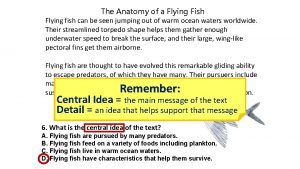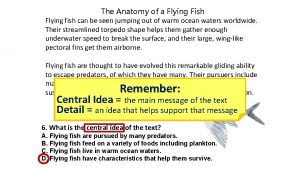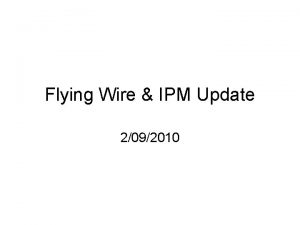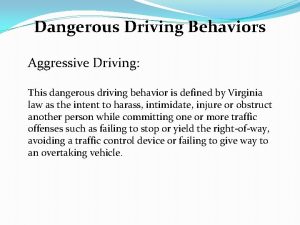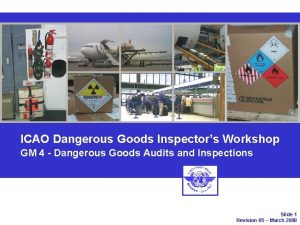is flying dangerous is flying dangerous The answer


































- Slides: 34

…is flying dangerous?

…is flying dangerous? The answer… is to be found inside ourselves.

Flying in itself isn’t more dangerous than a large number of human activities It becomes highly dangerous when safety margins are eroded.

It’s the conscious or inconscious reduction of safety margins which leads to an accident.

“keeping a safety margin” means: not being left without an alternative should the unexpected happen

safety margins can unconsciously be reduced because of: > lack of EDUCATION > lack of TRAINING > lack of CURRENCY > excess of SELF-CONFIDENCE EDUCATION: ability to make sound DECISIONS TRAINING: establishment of proper automated REACTIONS CURRENCY: continuous practice of the skills required in flying SELF-CONFIDENCE: complacency coming from a high degree of familiarity

safety margins are consciously reduced because of: > a high level of risk acceptance Risk is part of the game, and to someone it represents an important attraction. The level of risk acceptance is extremely variable among individuals. To some, confessedly or not, the quest for danger can be the strongest reason behind the decision to undertake a certain activity. BUT: even those who don’t usually seek danger can raise their risk acceptance level in force of a strong motivation, which pushes them to minimize or even ignore warning signals which appear down the road.

keeping a safety margin = not being left without an alternative should the unexpected happen this is a key concept for safe aeronautic behavior, and is founded on two important principles: PLANNING: setting up an action plan for any anomaly that can be foreseen PREPARATION: mental anticipation of a possible event aiming to offset the surprise effect

in case of EMERGENCY our life can depend on the way we manage the events

How to deal with an emergency: 1. recognize the emergency 2. keep flying the aircraft! 3. try resolving the emergency 4. adopt alternative plan

“piloting is essentially an endless chain of decisions, supported by a few good automated reactions”

We make these decisions following a mental process which is called “the operational chain”

1. PERCEPTION q 2. RECOGNITION q 3. EVALUATION q 4. PROJECTION q 5. DECISION q 6. ACTION

1. PERCEPTION It’s the picture the brain makes up with informations received from the senses. Unfortunately, being an interpretation, it can be sensibly different from the real thing. “ the brain sees mainly what it wants to see, and ignores what at first glance seems absurd or undesirable”

2. RECOGNITION The result of perception is compared with known situations, extracted from the memory. “ memory is a faculty upon which we have a very limited control. It can easily cancel many important informations, and at the same time remember lots of totally useless details”

3. EVALUATION The recognised situation is evaluated to assess whether it matches the desired one. “ the ability to anticipate as much as possible recognition and evaluation based on the very first clues is extremely important. Accident statistics show that often the cause is a serious delay in the recognition of a potentially dangerous situation. ”

4. PROJECTION An array of possible sceneries consequent to the observed situation are imagined, each one with its own developments. “ this phase can take time, if there are many possibilities to choose from. Quite often, a bad decision stems from an excessive number of possible choices. Hence, when flying, it’s desirable that decisions be reduced to the simple selection between two alternatives. ”

5. DECISION The action to be made is selected “ when confronted with critical situations, pilots should avoid, whenever possible, making an irreversible decision, by keeping a second possibility in store” 6. ACTION

When performing this task, our brain works much like a computer. Unfortunately, our processor is fairly slow. The best decisions rate it can achieve is 2 -3 per second, but when the task becomes more complex, performance drops dramatically. want an example?

when the road is empty, the decision of overtaking is easy, and quickly made…

…but if the space available is marginal we hesitate, and making a decision requires more time.

uncertainity sensibly slows down the decisionmaking process: right when we need a quick action, the brain finds it more difficult to decide.

When the decisionmaking process is seriously perturbated we are most at risk, and the eventuality of an accident increases. There a few known syndromes and character features which can negatively affect the way a pilot makes his/her decisions. Let’s see the most important ones.

Dangerous character features: > anti-authority: “rules can be broken, they are useless” > impulsive: “must do something now, anything” > invulnerable: “it will not happen to me” > macho “whatever happens, I will manage it” > resigned: “should something happen, what could I do? ”

There’s a little bit of this all inside each of us. Trouble is when one of these features is overwhelming, or missing altogether.

Syndromes which can perturbate the decisonmaking process: > a long period without an accident > the attraction of a goal > following the leader > “I’ve done it before” > “I know somebody who does it”

> a long period without an accident The longer things go on smoothly, the less conscious we become of the risks involved in our activities. He who has been involved or has witnessed an accident tends to be extra cautious immediately thereafter, but attention slowly fades again with time. If a pilot, out of ability and sheer luck, manages to avoid any accident in his flying career, he has never been confronted with a high risk situation, and this could dramatically show in his behavior, should a true emergency occur. “despite the false sense of security, this is the situation where we are most at risk!”

> the attraction of a goal Mountain climbers say that withdrawing before having reached the summit is exceedingly difficult. Visualizing the goal before actually seeing it has a mystic effect: it attracts and fascinates us, and induces us to minimize or even ignore the risks and dangers which we find along our path. “a strong motivation puts us inside a mental tunnel, from which too often there’s no exit”

> following the leader Blind-folded faith in somebody who runs before us, or whom we trust to be much more expert than us, is the same behavior of an animal in a herd. The leader, in panic, jumps from a cliff, and the herd follows suit. “leaving risk assessment to somebody else, rather than using judgment, can result in a disaster”

> “I’ve done it before” Imagine that somebody you trust wants to convince you that crossing a motorway on foot and blindfolded is perfectly safe, because he has done it the day before, and he’s still alive: you’d think he’s crazy. “and what do you call a pilot who ventures into high risk situations just because he has done it before, and has always been lucky? ”

> “I know somebody who does it” Being a responsible pilot means knowing your limits, and never trespassing them. Trying to reach, or worse beat somebody else’s limits, is a potentially deadly behavior. “just the fact that somebody is doing something doesn’t mean this makes sense, or it’s safe”

And then, …

…is flying dangerous? now we know… …where to look for the answer.

Fly safely, have fun copyright 2005 Flavio Formosa flavioform@inwind. it all rights reserved
 Hình ảnh bộ gõ cơ thể búng tay
Hình ảnh bộ gõ cơ thể búng tay Ng-html
Ng-html Bổ thể
Bổ thể Tỉ lệ cơ thể trẻ em
Tỉ lệ cơ thể trẻ em Gấu đi như thế nào
Gấu đi như thế nào Chụp tư thế worms-breton
Chụp tư thế worms-breton Alleluia hat len nguoi oi
Alleluia hat len nguoi oi Các môn thể thao bắt đầu bằng tiếng nhảy
Các môn thể thao bắt đầu bằng tiếng nhảy Thế nào là hệ số cao nhất
Thế nào là hệ số cao nhất Các châu lục và đại dương trên thế giới
Các châu lục và đại dương trên thế giới Công thức tính thế năng
Công thức tính thế năng Trời xanh đây là của chúng ta thể thơ
Trời xanh đây là của chúng ta thể thơ Mật thư anh em như thể tay chân
Mật thư anh em như thể tay chân 101012 bằng
101012 bằng độ dài liên kết
độ dài liên kết Các châu lục và đại dương trên thế giới
Các châu lục và đại dương trên thế giới Thể thơ truyền thống
Thể thơ truyền thống Quá trình desamine hóa có thể tạo ra
Quá trình desamine hóa có thể tạo ra Một số thể thơ truyền thống
Một số thể thơ truyền thống Cái miệng xinh xinh thế chỉ nói điều hay thôi
Cái miệng xinh xinh thế chỉ nói điều hay thôi Vẽ hình chiếu vuông góc của vật thể sau
Vẽ hình chiếu vuông góc của vật thể sau Nguyên nhân của sự mỏi cơ sinh 8
Nguyên nhân của sự mỏi cơ sinh 8 đặc điểm cơ thể của người tối cổ
đặc điểm cơ thể của người tối cổ V. c c
V. c c Vẽ hình chiếu đứng bằng cạnh của vật thể
Vẽ hình chiếu đứng bằng cạnh của vật thể Fecboak
Fecboak Thẻ vin
Thẻ vin đại từ thay thế
đại từ thay thế điện thế nghỉ
điện thế nghỉ Tư thế ngồi viết
Tư thế ngồi viết Diễn thế sinh thái là
Diễn thế sinh thái là Dot
Dot Số nguyên là gì
Số nguyên là gì Tư thế ngồi viết
Tư thế ngồi viết Lời thề hippocrates
Lời thề hippocrates










































